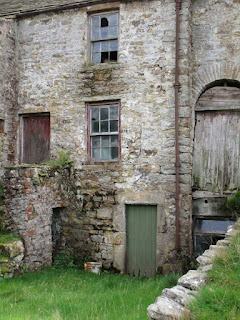The name of Byre Cottage – at Dodbury, at Garrigill, near Alston in northeast Cumbria – suggests it used to be essentially a cowshed, but the owners have turned it into a holiday cottage and it’s where I’ve just spent a week. Unlike some of the more basic places I’ve stayed, it’s modern and bright, and gazes over the valley of the South Tyne. A footpath runs right through the little garden, but I never saw evidence of anyone using it. These photos were all taken the morning I left, when the best weather of the week arrived!
There’s a lot of water about in this part of the world, some of it cascading in rocky falls. Beldy Fall was just yards from Byre Cottage; and Ashgill Force is a dizzying experience. The fall is at the top of a gorge: the bridge you can see in the photo carries a road across the top. You can, if you want to take the risk, stand behind the water and look outward as it crashes from fifty feet above. It’s not that likely that the whole thing is going to collapse, is it? There are gentler manifestations of water, too, at wide Kielder and rainy Ullswater.
You see the odd field of cows, but farming here means mainly sheep. It can’t ever have made for an easy living, but derelict farms like this one at Low Craig somehow express how hard it really could be. Imagine the last years of Low Craig.
That’s a different sort of economic scarring from the kind evident in the towns. Alston, a little market town a couple of miles from Garrigill, clambers over a steep hill with its market square halfway down. It’s clearly kept going by catering to tourists, walkers and bikers, but those are fewer than they once were. One of the cafés is closed, and what you might describe as a knickknack shop is heading that way too. I had a look round on Monday when everything was shut anyway, apart from the Cumberland Inn where I had lunch. So did everyone else: Monday’s always a busy day at the Cumberland, apparently, because there's nowhere else to go.
Picturesque Durham is a student city as much as anything else (I saw a queue of at least twenty outside Greggs at lunchtime) but the presence of lots of young people can’t disguise the closed shops there either. As for Newcastle, the streets around the city centre witness to the pride of a provincial capital, confident in its identity and prosperity: and thus in contrast to the hard times it now finds itself in. In handsome, red-sandstone Carlisle, even the Covered Market is half-empty, which is a bad sign when market stalls require so little investment, comparatively, to set up.
Towns like Penrith and Hexham, small but on the next step up from Alston, seem to be doing a bit better: they have their blank frontages and rubbish-strewn corners, but also their mobile coffee stands and side streets of little shops.
I’ll finish this section with a couple of bits of Art Deco, a bijou former cinema in Hexham and a building in Carlisle which uses the red sandstone in a proper 1930s idiom.


















No comments:
Post a Comment